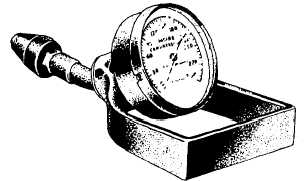short out the spark plugs one at a time. The noise will be greatly reduced when the piston in the cylinder that is responsible is not delivering power.
Piston-Pin Knock
Piston-pin knock is identified more as a metallic double-knock rather than a regular clicking sound like that heard in valve and tappet noise. In addition, it is most noticeable during idle with the spark advanced. A check can be made by idling the engine with the spark advanced and then shorting out the spark plugs. Piston-pin noise coming from a cylinder will be reduced somewhat when the spark plug for that cylinder is shorted out. Causes of this noise are a worn or loose piston-pin, a worn bushing, and a lack of oil.
Piston-Ring Noise
Piston-ring noise is also similar to valve and tappet noise since it is identified by a clicking, snapping, or rattling sound. This noise is most noticeable on acceleration. Low-ring tension, broken or worn rings, or worn cylinder walls will produce this sound. To avoid confusing this sound with other engine noise, make the following test: remove the spark plugs and add an ounce or two of heavy engine oil to each cylinder. Crank the engine for several revolutions to work the oil down past the rings. Replace the spark plugs and start the engine, If the noise has decreased, it is probable that the rings are at fault.
Piston Slap
Piston slap may be detected by a hollow, bell- like knock and is due to the rocking back and forth of the piston in the cylinder. If the slap occurs only when the engine is cold, it is probably not serious. However, if it occurs under all operating conditions, a further examination is called for. The slap can be caused by worn cylinder walls, worn pistons, collapsed piston skirts, or misaligned connecting rods.
Crankshaft Knock
Crankshaft knock is a heavy, dull, metallic knock that is noticeable when the engine is under load or accelerating. When the noise is regular, it can be contributed to worn main bearings. When irregular and sharp, the noise is probably due to worn thrust bearings.
ENGINE TESTING
In most shops, the Navy provides accurate and dependable testing equipment. But having the testing equipment in the shop is NOT enough. The supervisor and the crew must know how to use this equipment since proper use provides the quickest and surest means of finding out what is wrong and where the fault lies. Four of the most widely used testing instru- ments are the cylinder compression tester, vacuum gauge, cylinder leakage tester, and tachometer.
Compression Test
As you have learned, engine power results from igniting a combustible mixture that has been compressed in the combustion chamber of an engine cylinder. The tighter a given volume of fuel mixture is squeezed in the cylinder before it is ignited, the greater the power developed. Unless approximately the same power is developed in each cylinder, the engine will run unevenly. The cylinder compression tester (fig. 3-9) is used to measure cylinder pressure in psi, as the piston moves to TDC on the compression stroke.
By measuring compression pressures of all cylinders with a compression gauge, then comparing them with each other and with the manufacturer's specifications for a new engine, you get an accurate indication of engine condition.
The compression pressures in the different cylinders of an engine may vary as much as 20 pounds. The variation is caused largely by the lack of uniformity in the volume of the combustion chamber. It is nearly impossible to make all the combustion chambers in a cylinder head exactly the same size. For example, in a given engine with

Figure 3-9. - Cylinder compression tester.
Continue Reading